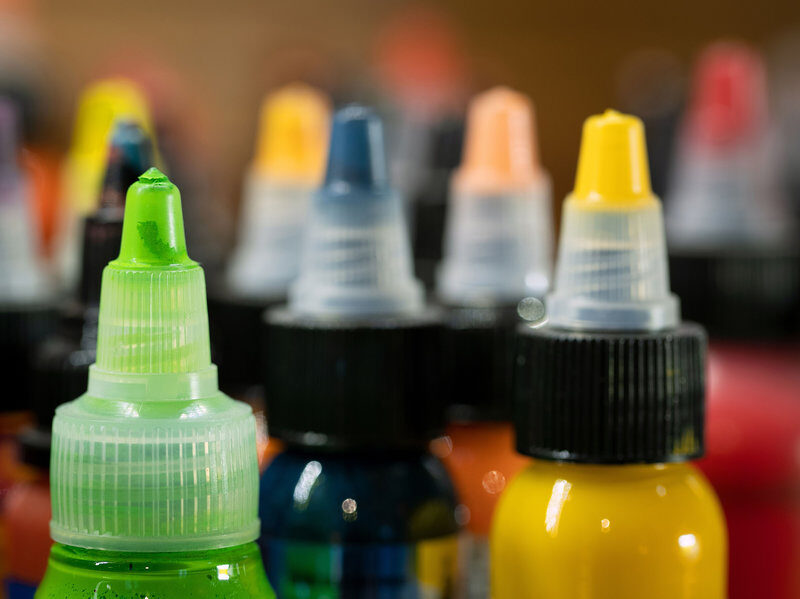
Meanwhile, in the United States, where about a third of Americans have a tattoo, tattoo ink is almost completely unregulated and there's little known about what's in tattoo ink.
Some artists here say the European restrictions don't make any sense.
"It's strange. You almost feel that, how are you only allowed to use certain inks?" says Matt Knopp, owner of Tattoo Paradise in Washington, D.C. "You can't tell me that all these other inks are bad, especially when I'm using them in the states."
For years, individual countries in Europe have required labeling of tattoo ink ingredients and have limited certain chemicals that are thought to cause cancer, damage DNA, or trigger allergic reactions.
Now the European Union is harmonizing tattoo ink rules across the continent. The new rules say that pigments called Blue 15:3 and Green 7 must be phased out over the next year. "That just went into action but is highly disputed," says Ines Schreiver, who studies tattoo ink at the German Federal Institute for Risk Assessment.
Her institute recently examined the two pigments and said they appeared to have "a comparatively low level of toxicity" but that it wasn't possible to provide a reliable health risk assessment because of a lack of data.
Mario Barth, the owner and founder of Intenze Tattoo Ink, made a video warning that the ban would have dire consequences. "It does not only affect all your green tones, or all your blue tones. It's also going to affect purples, some browns, a lot of the mixed tones, the muted tones, your skin tones, all this stuff," he says. "You're talking about 65-70% of the palette that a tattoo artist uses."
Barth previously helped found a group called the Coalition For Tattoo Safety, which has lobbied against proposed legislation that would strengthen oversight of tattoo inks in the U. S.
Walter Liszewski, a dermatologist and cancer researcher at Northwestern University who treats reactions to tattoos, says he's in favor of government oversight to ensure public safety. But he says extrapolating from lab studies to potential real-world health dangers in people can be difficult.
"The EU has really moved to be on the cautious side, and really sort of ban anything that even has the slightest suggestion that it could be a carcinogen," he says.
All of this is happening as tattoos have surged in popularity in recent years. One survey found that 40 percent of Americans aged 18 to 34 have a tattoo.
The art form goes back thousands of years, with tattoos found on mummies. But the small number of researchers working on questions related to its safety say that a lot about tattooing remains mysterious.
"The whole kind of picture, right down to what a tattoo actually looks like in the body, is still a surprisingly open research question," says John Swierk, a chemist at Binghamton University who just got a grant from the National Institutes of Health to study how the chemicals in tattoo inks can be changed by exposure to light.
One basic question that scientists have is:
What is actually in the ink?
Knopp recalls that that 30 years ago, it was hard to come by any information about what a tattoo shop was using. "They poured stuff out of these bottles that were wrapped and hidden, and you couldn't know what it was or you didn't know where they got it from," he says.
Sometimes artists made their own ink, testing it on themselves. "And then they would see if there was any kind of reaction," Knopp explains. "You know, did it bubble up, did it just come out, did it cause itchiness, did it do stuff like that? That was, you know, kind of your trial and error."

"We are still at a point where we don't know all the ingredients that are in the inks," says Schreiver. "And, unfortunately, it has to be said that it appears that sometimes even some manufacturers might also have the same problem, even though they produce the inks."
Raw ingredients purchased to make ink can have impurities, she says. And when one of her colleagues tested tattoo inks sold in Europe, it turned out that a third had labels didn't accurately reflect the pigments inside.
A search of a European consumer safety website shows that dozens of tattoo inks have been pulled from markets there in the last few years, because of violations like excessive amounts of copper, nickel, lead, cobalt, and arsenic.
In the U. S., "ink manufacturers aren't even required to disclose what they put into the inks," says Swierk. "Within the U. S., there really hasn't been a lot of effort placed into understanding what goes into these inks."
Then there's the question of what happens to these inks over time, he says, and whether sunlight or the body can break the chemicals down into byproducts that have their own potential effects.
Swierk has been working to analyze commercially available inks and wants to make information about them public. "I want to empower artists and clients to really make informed decisions," he says.
As his lab tries to break down the inks for analysis, some are proving resistant to techniques that involve acids, high pressure, and high temperatures. "We actually can't completely break down some of these inks, which is a little bit concerning," says Swierk. "Based on what is supposed to be in these inks, we should be able to break them down all the way."
All of this leads to a second open question that researchers are trying to answer:
How do the inks interact with the body?
It's only been in the last few years that scientists have understood which cells in the skin actually take up and hold tattoo pigment.
Sandrine Henri of the Centre d'Immunologie de Marseille-Luminy says that she and her colleagues were interested in melanin, a natural skin pigment, and as part of that work they started wondering how the skin deals with the injected pigments in a tattoo.
"We looked at the literature and nothing was known," says Henri.
Some thought tattoo ink colored a common type of skin cell called a fibroblast. Others noted that some ink was going into immune cells called macrophages, a type of white blood cell that engulfs foreign substances or microbes.
Henri knew that macrophages were not living for as long as a tattoo could persist. "There is no way macrophages in a tissue will live for 50 years," she says.
Her research team ended up doing a mouse study showing that macrophages do gobble up large amounts of tattoo pigment. But when these cells die, they release the pigment. It gets taken up by new macrophages in a continuous cycle of capture, release, and re-capture.
"We believe it's a constant turnover," says Henri. "It's a very dynamic process."
In a follow-up study, she and her colleagues found that fibroblasts also will take up tattoo ink, but they don't hold as much as the macrophages.
The body may try to break some tattoo ink components down, but the main strategy seems to seal it off and keep it in the skin. This isn't a perfect process.
Surgeons who do biopsies have long noted that tattooed people can have lymph nodes that are stained with color. A few years ago, Schreiver and her colleagues analyzed tattooed human skin and lymph nodes from corpses. They found evidence that smaller pigment particles can indeed migrate from the skin towards the lymph nodes.
What's more, during the tattooing process it's not uncommon for drops of blood to appear, showing that blood vessels can be damaged and give the ink access to the bloodstream.
"It's very, very likely that tattoo pigments will also end up in other organs, but in a very minor amount compared to the skin and lymph nodes," says Schreiver.
So, if some tattoo ink components can move through the body, researchers want to know:
Are there any long-term health risks?
Sometimes people have reactions to tattoo inks, and these can occur months or years after the ink goes in — although it's not clear why.
A survey of 300 tattooed people in New York's Central Park found that 6% reported having a chronic reaction — such as itchiness, swelling, scaliness, or raised skin — involving a specific color such as black or red that lasted for more than four months.
One participant "described a red reaction developing two weeks after a new tattoo, with subsequent development of a similar response in the red ink portion of an 8-year-old tattoo," the researchers wrote.
Red seems to be the color most often associated with reactions, says Liszewski, but he points out that lots of compounds could be used to make red.
"If someone is allergic to red, you've got no idea which one they're allergic to. Because individuals who are tattooed, they don't know the ink that was used," he explains. "There is no record keeping because their tattoo artist isn't required to, and tattoo artists may use multiple different inks. It's really hard to tell which ink is at play."
While an allergic reaction might not be a big deal for a small tattoo, that's not true if someone has a whole sleeve or any other kind of large tattoo. "That can be very, very uncomfortable. It alters your quality of life," says Liszewski. One study found the level of discomfort could be similar to that caused by skin diseases like psoriasis and eczema.
Liszewski, who also is a cancer epidemiologist, says it's hard to investigate whether or not tattoo pigments in the body lead to any long-term increased risk of diseases like cancer.
Any effort to find out would have to factor in all the different inks used, the differing amount of skin area covered, and the different amounts of time that people had their tattoos.
"I would love some way to get data to really look and see if there is an association between malignancy and tattoos," says Liszewski, "but there's just multiple layers of data that we don't have, and complexities that make it very, very difficult."
Still, some researchers in Europe are now looking to see if tattoos have any links to immune-related cancers or skin cancers.
Liszewski is not anti-tattoo. He says they can have a lot of personal meaning for people and that body art can be an important way to memorialize "someone who may have died, or an event that they had."
And tattooing is so common nowadays that the researchers studying tattoos, even if they aren't inked, know others who are.
"Some of the people working on the project have tattoos, other people working on different projects in the lab have tattoos," says Swierk. "It can make for some very uncomfortable group meetings, when you start talking about some of these potential health outcomes."



Comment: See also: